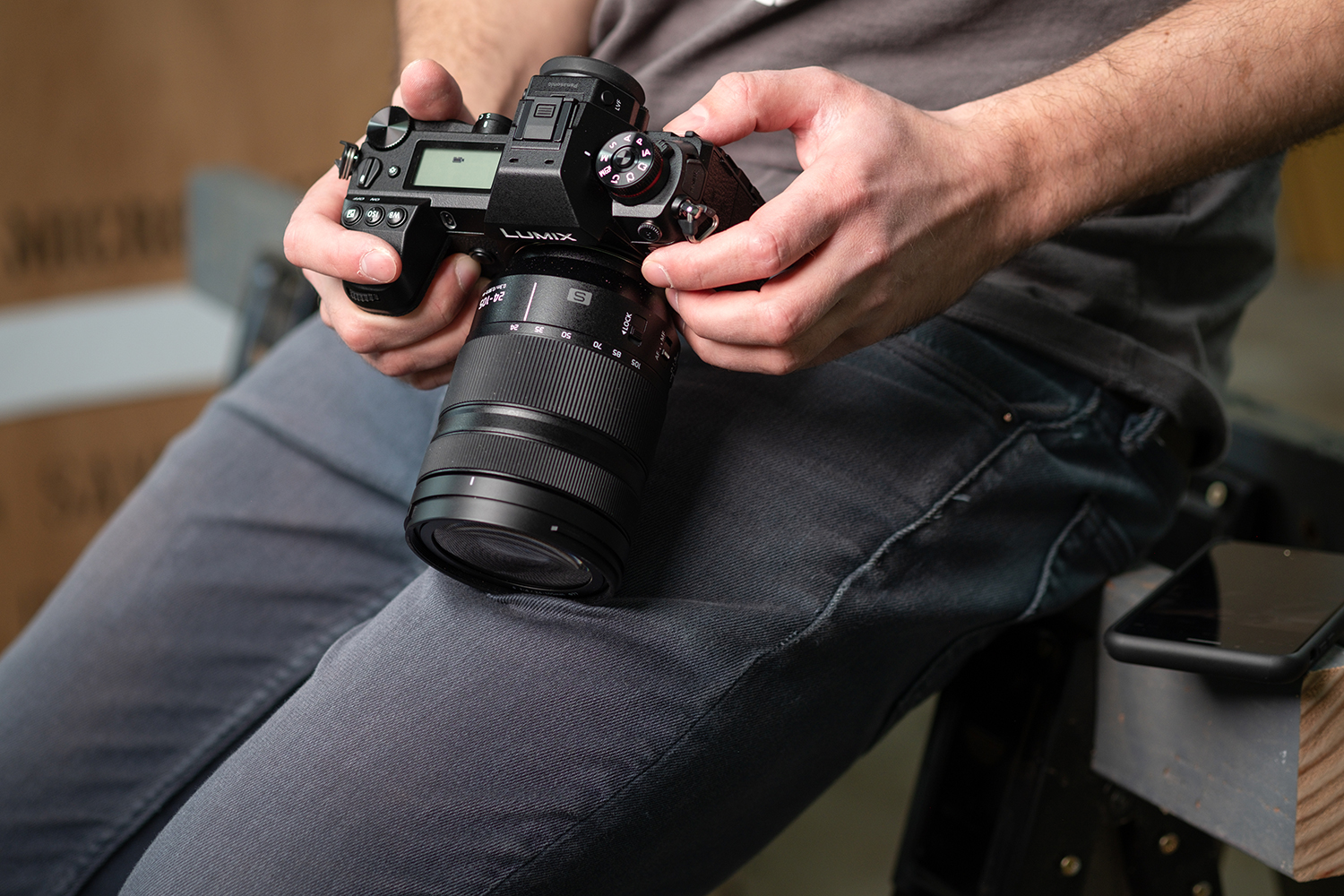The Sony A7 III and Panasonic Lumix S1 are both 24-megapixel, full-frame mirrorless cameras — but other than that, they couldn’t be more different. The Sony takes a streamlined approach, with a slimmer and lighter design, while the Lumix looks and feels like a professional DSLR — bulky, but with much more direct access control. The S1 also features a high-resolution mode that produces 96MP images, a significantly sharper electronic viewfinder (EVF), support for faster memory cards, and more advanced video features coming via paid firmware update.
Looking at the spec sheet alone, the Lumix S1 seems like the clear winner, but the A7 III still holds it own in real-world use. It also costs $500 less, at just $2,000 compared to $2,500 for the S1. So which is right for you? Here’s how these two cameras stack up.
| Sony A7 III
|
Panasonic Lumix S1
|
|
| Sensor | 24-megapixel full-frame sensor | 24-megapixel full-frame sensor |
| Burst speed | 10 fps w/ AF-C (8 fps with live view) | 9 fps (6 with AF-C) |
| Shutter speed | 1/8,000 to 30 sec. | 1/8,000 to 60 sec. |
| ISO | 100-51,200 (50-204,800 extended) | 100-51,200 (50-204,800 expanded) |
| Autofocus | 693-point hybrid phase-detection contrast AF | 225-point contrast-detection DFD AF |
| Image stabilization | 5-axis sensor-shift stabilization | 5-axis sensor-shift stabilization |
| Video | 4K/30p, 1080/120p, S-Log, 8-bit | 4K/30p, 4K/60p with 1.5x crop, HLG (V-Log via firmware update) |
| Viewfinder | 2.35m-dot EVF | 5.7m-dot OLED EVF |
| LCD | 2.95 inch, 921,00 dot tilting touchscreen | 3.2-inch, 2.1m-dot tilting touchscreen |
| Connectivity | Wi-Fi, Bluetooth | Wi-Fi, Bluetooth |
| Media slots | 1 SD, 1 Memory Stick Duo or SD | 1 SD, 1 XQD (CFexpress support coming) |
| Battery | Li-ion rated for 610 shots | Li-ion rated for 380 shots |
| Dimensions (WxHxD) | 5 x 3.87 x 3 inches | 5.87 x 4.33 x 3.82 inches |
| Weight | 22.9 ounces | 35.8 ounces |
| Kit lens | Available body only or with 24-70mm f/3.5-5.6 | Available body only or with 24-105mm f/4 |
| Price | $2,000 body-only | $2,500 body-only |
| Read more | Sony A7 III review | Panasonic Lumix S1 Review |
| Buy now | Amazon | Amazon |
Sensor
While both the Sony A7 III and Panasonic Lumix S1 feature 24MP full-frame sensors, only the S1 has a multi-shot high-resolution mode. This uses the stabilization gimbal to shift the sensor slightly between images, taking eight exposures in total and combining them into a single photo with a resolution of 96MP. This mode requires a tripod and a perfectly still subject, so it’s best used for landscapes and still-life scenes.
Other than that, both sensors produce remarkable image quality and have equal ISO ratings and excellent noise performance. If you don’t need — or simply can’t use — the high-resolution mode on the S1, then there’s nothing you’ll give up, image quality wise, by going with the A7 III.
- 1. Shot on Sony A7 III
- 2. Shot on Lumix S1
Winner: Lumix S1
Speed
While the numbers are close, the A7 III and the S1 have different limitations when it comes to high-speed continuous shooting. The A7 III can hit 10 frames per second with continuous autofocus, but without live view; the S1 manages a respectable 9 fps with live view, but without continuous autofocus. The Sony slows to 8 fps to get both live view and continuous autofocus together, while the Lumix has to drop down to 6. We’re giving the Sony the win here, although the difference may not be appreciable for all photographers.
Winner: Sony A7 III
Autofocus
This is one area where the companies take an inherently different approach. Sony uses on-chip phase-detection autofocus with 650 focus points spread over the frame. Panasonic uses its proprietary Depth from Defocus (DFD) system, which is based on contrast-detection and split into 225 zones. While contrast detection is normally slower than phase detection, DFD speeds it up considerably; in our testing, it performed nearly equally to phase-detect systems most of the time — but not all of the time.
We’ve found Sony’s autofocus to be more reliable, especially when it comes to tracking moving subjects. This has been made even better with the recent upgrade to Real-Time Tracking and Real-Time Eye AF, which added artificial intelligence-based focusing algorithms that make the A7 III even more accurate. For its part, the Lumix S1 also has a subject and eye-detection mode that works quite well, but, again, is slightly less reliable than Sony’s.
One potential benefit of the S1’s contrast-detect autofocus is that it doesn’t require special phase-detect pixels on the sensor, which, in theory, can allow for more extreme exposure pushes in post without running into “banding” problems. In practice, we never noticed banding on the A7 III, so the real-world advantage of this may be slim to none.
Winner: Sony A7 III
Design
The Lumix S1 is by far the heavier and larger of the two, weighing in at over 2 pounds with the battery loaded. But if you can get over the weight, it offers the most functional and complete control layout of any mirrorless camera we’ve ever tested; the A7 III is empty by comparison. Some of the S1’s buttons even light up, making them easier to see when shooting in low light scenes.
While both cameras claim environmental sealing, the S1 certainly feels like the more durable of the two. It also boasts the highest-resolution electronic viewfinder on the market, with 5.7 million pixels — over 3 million more than the A7 III. The 3.2-inch, 2.1 million-dot screen is also larger and higher resolution than the Sony’s 3-inch, 921,600-dot screen. The S1 also has a large, secondary LCD on the top of the camera for displaying shooting settings.
Both cameras offer dual memory card slots, but where the A7 III uses SD cards for both, the S1 gives you one SD and one XQD. Not only are XQD cards faster than SD, but they are physically identical to even higher-speed CFexpress cards, support for which is coming to the S1 in a future firmware update.
Winner: Lumix S1
Stabilization
Both cameras use 5-axis sensor-shift stabilization to counter camera motion when handholding, and both do a very good job in still and video modes. The A7 III’s stabilization is rated for 5.5 stops of shake reduction, where the S1’s is good for 6 — or 6.5 when paired with an optically stabilized lens. It’s not a huge difference, but the Lumix takes another win here.
Winner: Lumix S1
Video
Both Sony and Panasonic are well known as video companies. Sony was one of the first to put 4K into a mirrorless camera, and Panasonic’s GH series (built on the smaller Micro Four Thirds format) continues to present us with some of the best video cameras you can buy. The Lumix S1 isn’t really targeting that same audience, but it still packs a punch when it comes to video features. Even compared to the more expensive Lumix S1R, it has some pretty big advantages.
The S1 can shoot oversampled 4K/30 from the full width of the sensor, or 4K/60 from an APS-C crop. The A7 III tops out at 4K/30. Both cameras offer higher frame rates at lower resolutions for shooting in slow motion.
The A7 III includes Sony’s advanced S-Log color profiles for greater dynamic range, but video is still limited to 8-bit — whether recording internally or externally over HDMI. The S1 is also currently limited to 8-bit, unless you shoot in Hybrid Log Gamma (HLG) which opens up 10-bit output. A future firmware update will also bring Panasonic’s V-Log profile and 10-bit 4:2:2 recording to the S1; however, this will be a paid update.
Winner: Lumix S1
Battery life
The Sony A7 III boasts one of the highest battery ratings we’ve ever seen on a mirrorless camera at 650 exposures. That’s a fair margin above the Lumix S1’s 380-exposure rating. However, the S1’s poor performance here is likely thanks to its much higher resolution EVF and monitor, a tradeoff that may be well worth it for some photographers.
Perhaps because its engineers realized how much power the S1 was going to consume, Panasonic also built in a special Power Save Live View Finder (LVF) Shooting mode, which somewhat mimics how a DSLR manages power. In this mode, the camera will go to sleep after a short time, but will leave some functions active, like the EVF eye sensor and shutter button. Battery life is stated as over 1,000 exposures in this mode.
We’re still calling this one in Sony’s favor, but whichever camera you choose, we recommend picking up a spare battery or two.
Winner: Sony A7 III
Lenses
Sony’s E-mount is part of a much more mature system than the Panasonic S series, and thus has quite a few more native lenses available at this time. However, the S1 is built around the Leica L mount, which already has a collection of lenses that are fully compatible (but expensive — they’re made by Leica, after all). Additionally, Sigma has signed on to develop L-mount lenses, with 11 of their acclaimed Art-series lenses currently on the way. Of the three Lumix S lenses currently available from Panasonic, the S Pro 50mm f/1.4 is also one of the best 50mm lenses we’ve ever seen — of course, at $2,300, it should be.
As of this moment, Sony is ahead in pure numbers, but things will look a lot different over the next 12 months. This one is too close to call, but it’s a good idea to check if a system has any particular lenses you want before buying into it.
Winner: Tie
Picking an overall winner
The Lumix S1 is almost two cameras in one. It’s a hybrid still/video machine with excellent low-light performance from its 24MP sensor, and an ultra-high-resolution camera capable of shooting 96MP images when you need detail over speed. It is also the more durable and more professional of the two, with an absolutely gorgeous EVF and expertly-designed control layout.
But the Sony still comes out ahead in some areas, such as continuous shooting speed and autofocus performance. It also is quite a bit less expensive, meaning you can save some money to put toward a nice lens. If money is no object, we say go with the S1; it is one of the most forward-thinking cameras we have ever tested and is built with professionals in mind. But the A7 III is a great value at just $2,000; for enthusiasts on a tighter budget, it makes a lot of sense.













